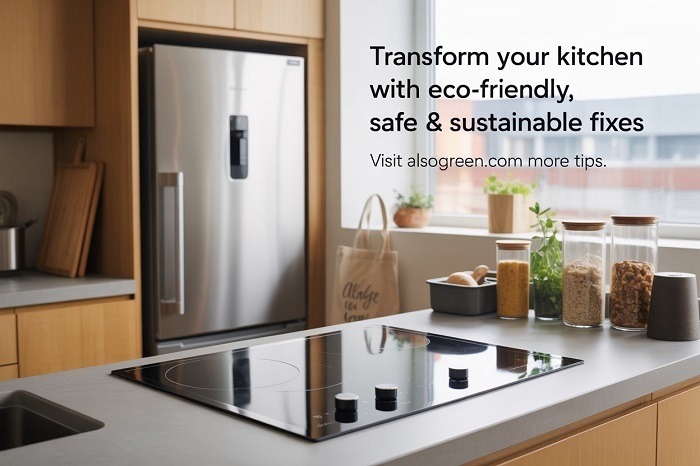The Ultimate Eco-Friendly Kitchen Checklist: Safe, Sustainable & Budget-Smart Fixes
Transform your kitchen with eco-friendly upgrades! Discover tips on non-toxic essentials, zero-waste swaps, and budget-smart fixes for a sustainable kitchen.


The Ultimate Eco-Friendly Kitchen Checklist: Safe, Sustainable & Budget-Smart Fixes
In today's environmentally conscious world, transforming your kitchen into an eco-friendly, safe, and sustainable space is more important than ever. The kitchen is not just the heart of your home for preparing meals, but it's also where some of the most harmful toxins, waste, and plastic are used. Whether you're aiming to make small changes or planning a complete kitchen overhaul, this ultimate guide provides you with practical, budget-smart fixes that will reduce waste, eliminate toxins, and help save energy.
This checklist addresses the most common questions people have about creating an eco-friendly kitchen, providing solutions that are not only sustainable but also safe for you and your family.
1. Declutter and Detox Your Kitchen: Say Goodbye to Toxins
One of the first steps to building an eco-friendly kitchen is eliminating harmful toxins and chemicals that can be found in many of the products you use daily.
How can I make my kitchen more eco-friendly on a budget?
Budget-friendly and eco-friendly kitchen solutions start with replacing harmful items, such as non-stick cookware, plastic storage containers, and toxic cleaning supplies. Swap them for alternatives like stainless steel, Glass, and natural cleaning products.
Toxic chemicals like BPA and phthalates are often found in plastic food containers, water bottles, and even kitchen utensils. Replacing these with glass containers, stainless steel utensils, and bamboo cutting boards is an affordable yet effective way to reduce exposure to harmful chemicals. Glass is especially suitable for food storage, as it doesn't leach chemicals and is long-lasting.
What are the best eco-friendly kitchen appliances?
Switching to energy-efficient kitchen appliances, such as induction cooktops, convection ovens, and ENERGY STAR-rated refrigerators, can significantly reduce your energy consumption. These appliances consume less power, which helps reduce both your energy bills and your carbon footprint.
2. Sustainable Cooking: Reducing Energy Use and Waste
Sustainable cooking practices not only help reduce energy usage but also minimize food waste. Here's how you can cook more efficiently while prioritizing the planet.
How can I make my kitchen more energy-efficient?
Energy-efficient kitchen tips include using appliances like slow cookers and pressure cookers, which can save a significant amount of energy compared to traditional stovetop cooking methods. Additionally, using induction cooktops or convection ovens can further reduce energy use, as they heat food more quickly and evenly.
Sustainable Cooking Techniques
When cooking, always try to meal prep in bulk, which will save you time and energy in the long run. Cooking larger batches of food at once minimizes energy consumption and helps reduce food waste.
How do I reduce food waste in my kitchen?
Start by composting food scraps—it's an easy way to minimize waste while enriching your garden with organic nutrients. Also, consider implementing clever food storage techniques to extend the shelf life of your produce and leftovers.
3. Zero-Waste and Plastic-Free Kitchen: Practical Swaps to Reduce Waste
Reducing waste is a core element of an eco-friendly kitchen. A zero-waste kitchen focuses on minimizing your reliance on disposable items and single-use plastics. Below are some zero-waste kitchen swaps that will help you live more sustainably without compromising convenience.
What are zero-waste swaps for everyday kitchen items?
Replace plastic food wraps with beeswax wraps, which are reusable and biodegradable. Additionally, replace plastic bags with reusable silicone bags for storing food. Stainless steel containers are ideal for keeping food fresh and last longer than plastic containers.
Plastic-Free Kitchen Storage Solutions
Instead of plastic containers, use glass jars or bamboo storage containers for everything from pantry staples to leftovers. These are not only eco-friendly but also non-toxic, ensuring your food stays safe and fresh.
4. Budget-Smart Sustainable Kitchen Upgrades
Making your kitchen eco-friendly doesn't have to break the bank. Numerous budget-friendly sustainable kitchen upgrades can significantly enhance your home without incurring substantial costs.
How do I reduce plastic use in my kitchen?
Start by replacing disposable items, such as plastic cutlery, plates, and straws, with reusable alternatives made from bamboo or stainless steel. These swaps reduce plastic consumption while providing durable, long-lasting options.
LED Lighting
Switch to LED bulbs, which use significantly less energy and last much longer than incandescent light bulbs. This simple switch can help you save money on your energy bill while also being more environmentally friendly.
Water-Saving Faucets
Install low-flow faucets or faucet aerators to reduce water wastage. These devices regulate the water flow while maintaining pressure, saving both water and money over time.
5. Maintaining Your Eco-Friendly Kitchen
Once your kitchen is eco-friendly, the next step is to maintain it. Regular upkeep ensures that your sustainable appliances continue to operate at peak efficiency and that your kitchen remains safe for you and your family.
Regular Cleaning with Eco-Friendly Products
Use natural cleaning solutions made from vinegar, baking soda, and essential oils to clean countertops, floors, and appliances. These natural products are effective at removing grime without contributing to indoor pollution or harming the planet.
Organizing for Sustainability
Set up an organized composting system and store reusable items in easily accessible places to encourage ongoing use. Keep your kitchen tidy and label storage containers to ensure you consistently use eco-friendly options.
Conclusion: Taking Action for a Greener Kitchen
Adopting an eco-friendly kitchen doesn't have to be a significant overhaul. You can start small with practical, budget-friendly fixes, such as swapping out plastic containers, reducing food waste, and upgrading to energy-efficient appliances. These changes will not only benefit the environment but also make your kitchen a safer and healthier place to live.
Remember, it's about making small changes over time, and every little effort counts. By following this checklist, you can create a kitchen that's both sustainable and safe for your family without breaking the bank.
Shop eco-friendly products now and get your kitchen started on its path to sustainability. From zero-waste swaps to energy-efficient appliances, we've got everything you need to make your kitchen greener and healthier.
FAQS Section:
How can I make my kitchen more sustainable on a budget?
Start by replacing plastic containers with Glass, using energy-efficient appliances, and switching to LED lighting. Over time, you can add more sustainable upgrades without breaking your budget.
What are some eco-friendly kitchen appliances I should consider?
Look for energy-efficient kitchen appliances, such as induction stoves, convection ovens, and refrigerators, that are ENERGY STAR-rated. These help reduce your energy consumption and lower your utility bills.
How do I reduce plastic use in my kitchen?
Replace plastic items with beeswax wraps, silicone bags, and glass or stainless-steel containers. These eco-friendly alternatives reduce your reliance on single-use plastics.
What are the benefits of a non-toxic kitchen?
A non-toxic kitchen eliminates harmful chemicals from your cooking and cleaning products, reducing your exposure to potential health risks. It also helps create a cleaner, safer environment for your family.
Also Green
Embrace a mindful and eco-friendly lifestyle today.
Contact
contact@alsogreen.com
© 2025 Also Green. All Rights Reserved
+14706521930
